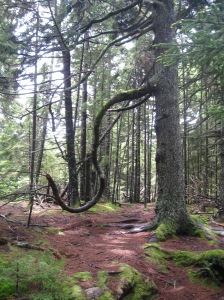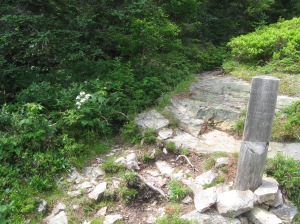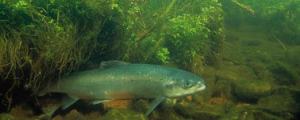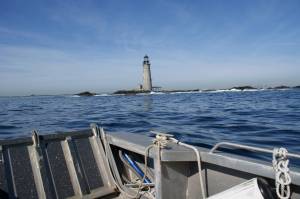Most interns expect to be the victim of some sort of initiation ritual, constant questions like “what’s your name” and “what are you doing here”, persistent condescending tones, or at least a first-week deluge of menial tasks. So far, I’ve had nothing but exciting, educational adventures in the field; field researchers have been receptive and instructive; my daily assignments have rarely been bland. I feel happily exhausted and accomplished at the end of each day. When I was told that I would be sent trudging through a deep stream in chest-high waders Monday afternoon, I began to wonder if this would be the dreaded assignment that would catapult me into the ranks of miserable interns – the gofers and guinea pigs of the working world. Not so. I’m not sure if anyone else feels the same about their first experience wearing waders, but mine was filled with childlike glee. Stepping into the water without getting wet was surreal. I didn’t expect the pants of the overalls to suction to my leg, but it was a comforting pressure and made me feel much smaller and more graceful as my globular, waterproofed mass moved upstream. Now that stooping in a stream in the homeliest of get-ups to clean rocks, pick leaf litter from a net, and jar bugs has failed to dim my spirit, I’m pretty certain that what boosts my enthusiasm for any field work day is more than dedication, work ethic, or complacency. What stokes my zeal, no matter how wet or muddy I get or how far I trudge, is a genuine enchantment with the smallest wonders, like the tube of grit and rock chips hollowed out by a caddisfly making his home. What motivates me to make the most of each opportunity is a heart-, soul-, and mind-burning interest in how science sorts intricate processes into simple steps for observation and analysis.
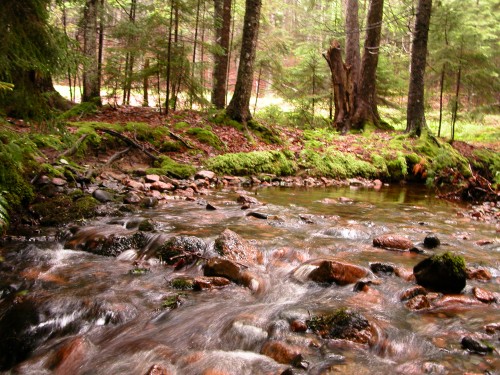
Stanley Brook © S. Delheimer.
Monday afternoon, after suiting up, I traipsed (an awkward and physically challenging feat in thick overalls and rubber boots) down to the banks of Stanley Brook with John and Bik to check a small section for stream invertebrates. The procedure was surprisingly simple, so simple that my mentors agreed to let me take a crack at it. I squatted down in the stream holding the specially crafted bucket just downstream of a mesh sack of rocks that were covered in leaf litter, grime, and hopefully a few bugs. Without hesitation, I snatched the bag of rocks and dropped it into the pail. A successful transfer. I lugged the bucket over to our makeshift supply station along the water’s edge. Holding the bag over the bucket, I opened the drawstring net and gave it a small shake, letting the rocks tumble back into the bucket. The three of us set to work, wishing we had the nimble fingers of a pianist, plucking leaves and twigs and other litter off the net and placing it in the bucket with the rocks. With the net picked clean, we moved on to the rocks, gently rubbing each one with one hand while rinsing it under a jet of water that the other hand pumped from a small water bottle and sent all the grit and grime back into the bucket. Clean rocks were placed back in the drawstring net and once full, the bag returned to its post in the stream. The leaf litter was emptied into labeled mason jars. As we stuffed the jars full, we looked for any signs of life – backswimmers, mayflies, caddisflies, and other aquatic invertebrates. We found four insects in two sacks of rocks, but whoever is assigned the task of carefully sorting through all the leaves and dirt and twigs will likely find more. Jars stuffed, we filled them 70% full with alcohol (to preserve the bugs for identification using a microscope and dichotomous key) and added just enough water to reach the neck of the jar. Having emptied two of the three bags in our particular section of the stream and after concluding that there was no third bag to be found (perhaps a passerby thought it would make the perfect souvenir?), we called it a day and loaded the truck with our jars and stepped out of our wading gear.

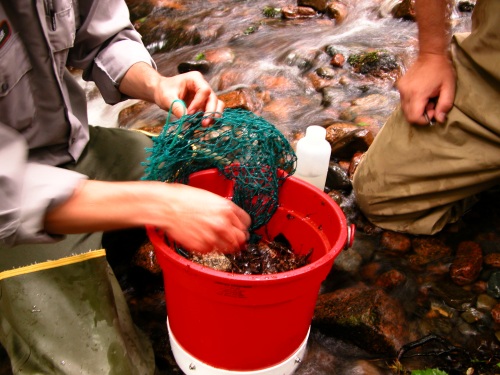
The abundance and diversity of invertebrates in Acadia National Park’s streams is one indicator of stream health. The community of life in a stream varies with its position along the length of the stream from rushing headwaters to flatter, slow-moving meanders. A stream is a continuum of life. Invertebrates are key components of the stream ecosystems and crucial links in many aquatic food chains. Aquatic insects are an important part of the diets of many fish species. Because populations of stream invertebrates shift with stream size and food production and fish follow the presence of their preferred insect food, researchers at Acadia NP question whether the migration of anadromous brook trout populations is affected by changes in stream invertebrate populations. The stream invertebrate monitoring program seeks to answer such questions as: Does the number of stream invertebrates in Acadia NP’s streams provide a sufficient food supply for fish populations? What types of stream invertebrates are found in Acadia NP’s streams and what does this say about the quality of forage for fish?
Previous stream invertebrate monitoring projects looked only at communities around a single station, leaving gaps in the Park’s understanding of how stream invertebrate populations vary up and down the length of a stream. Monitoring stream invertebrates with nets at a number of sites along the length of a stream will provide much needed baseline information and will allow researchers to analyze trends in stream health.



